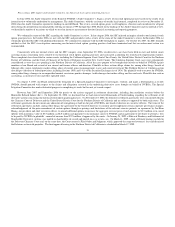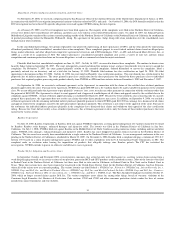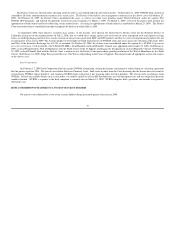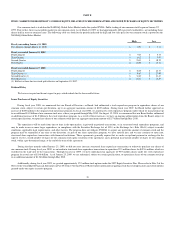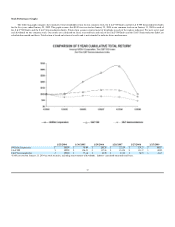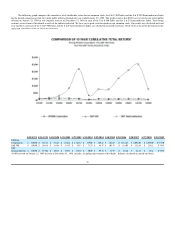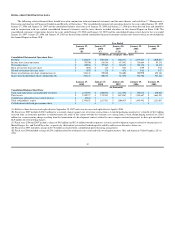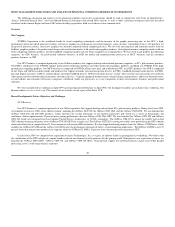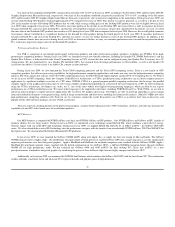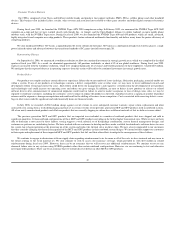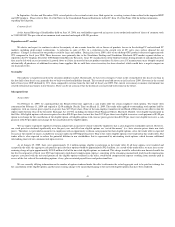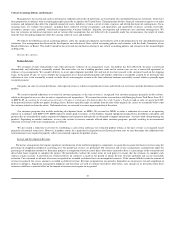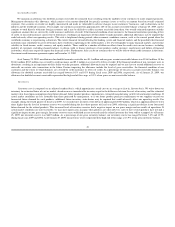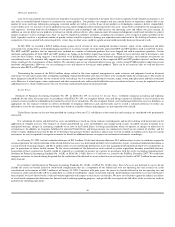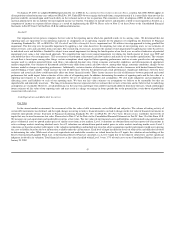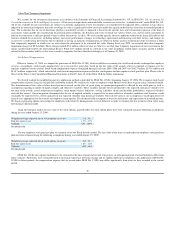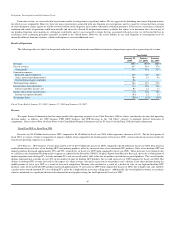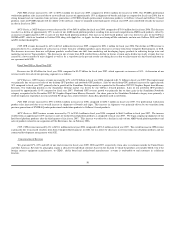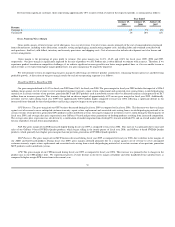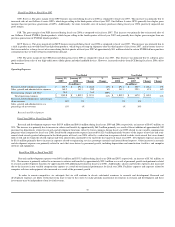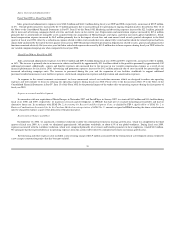NVIDIA 2008 Annual Report Download - page 46
Download and view the complete annual report
Please find page 46 of the 2008 NVIDIA annual report below. You can navigate through the pages in the report by either clicking on the pages listed below, or by using the keyword search tool below to find specific information within the annual report.
In September, October and November 2008, several putative class action lawsuits were filed against us, asserting various claims related to the impacted MCP
and GPU products. Please refer to Note 12 of the Notes to the Consolidated Financial Statements in Part IV, Item 15 of this Form 10
-
K for further information
regarding this litigation.
Common Stock
At the Annual Meeting of Stockholders held on June 19, 2008, our stockholders approved an increase in our authorized number of shares of common stock
to 2,000,000,000. The par value of our common stock remained unchanged at $0.001 per share.
Dependence on PC market
We derive and expect to continue to derive the majority of our revenue from the sale or license of products for use in the desktop PC and notebook PC
markets, including professional workstations. A reduction in sales of PCs, or a reduction in the growth rate of PC sales, may reduce demand for our
products. Changes in demand for our products could be large and sudden. During fiscal year 2009, sales of our desktop GPU products decreased approximately
29% compared to fiscal year 2008. These decreases were primarily due to the Standalone Desktop and Standalone Notebook GPU market segment decline as
reported in the PC Graphics December 2008 Report from Mercury Research. Since PC manufacturers often build inventories during periods of anticipated growth,
they may be left with excess inventories if growth slows or if they incorrectly forecast product transitions. In these cases, PC manufacturers may abruptly suspend
substantially all purchases of additional inventory from suppliers like us until their excess inventory has been absorbed, which would have a negative impact on
our financial results.
Seasonality
Our industry is largely focused on the consumer products market. Historically, we have seen stronger revenue in the second half of our fiscal year than in
the first half of our fiscal year, primarily due to back
-
to
-
school and holiday demand. This seasonal trend did not occur in fiscal year 2009. Revenue in the second
half of fiscal year 2009 declined by 33% when compared to revenue from the first half of fiscal year 2009. The current recessionary economic environment has
created substantial uncertainty in our business. There can be no assurance that the historical seasonal trend will resume in the future.
Subsequent Event
Tender Offer
On February 11, 2009, we announced that our Board of Directors approved a cash tender offer for certain employee stock options. The tender offer
commenced on February 11, 2009 and expired at 12:00 midnight (Pacific Time) on March 11, 2009. The tender offer applied to outstanding stock options held by
employees with an exercise price equal to or greater than $17.50 per share. None of the non
-
employee members of our Board of Directors or our officers who file
reports under Section 16(a) of the Securities Exchange Act of 1934, including our former Chief Financial Officer, Marvin D. Burkett, were eligible to participate in
the Offer. All eligible options with exercise prices less than $28.00 per share, but not less than $17.50 per share were eligible to receive a cash payment of $3.00 per
option in exchange for the cancellation of the eligible option. All eligible options with exercise prices greater than $28.00 per share were eligible to receive a cash
payment of $2.00 per option in exchange for the cancellation of the eligible option.
We use equity to promote employee retention and provide an incentive vehicle valued by employees that is also aligned to stockholder interest. However,
our stock price has declined significantly over the past year, and all of our eligible options are “out
-
of
-
the
-
money”
(
i.e., have exercise prices above our stock
price). Therefore, we provided an incentive to employees with an opportunity to obtain cash payment for their eligible options. Also, the tender offer is expected
to increase the number of shares available for issuance under our 2007 Equity Incentive Plan to the extent eligible options were tendered in this tender offer. The
tender offer is also expected to reduce the potential dilution to our stockholders that is represented by outstanding stock options, which become additional
outstanding shares of our common stock upon exercise.
As of January 25, 2009, there were approximately 33.1 million options eligible to participate in the tender offer. If all these options were tendered and
accepted in the offer, the aggregate cash purchase price for these options would be approximately $92.0 million. As a result of the tender offer, we may incur a non
-
recurring charge of up to approximately $150.0 million if all of the unvested eligible options are tendered. This charge would be reflected in our financial results for
the first fiscal quarter of fiscal year 2010 and represents stock
-
based compensation expense, consisting of the remaining unamortized stock
-
based compensation
expense associated with the unvested portion of the eligible options tendered in the offer, stock
-
based compensation expense resulting from amounts paid in
excess of the fair value of the underlying options, if any, plus associated payroll taxes and professional fees.
We are currently tallying information on the number of options tendered under the offer to determine the actual aggregate cash to be paid in exchange for
the cancellation of the eligible options and the non
-
recurring charge to be incurred pertaining to the unvested eligible options that have been tendered.
43


